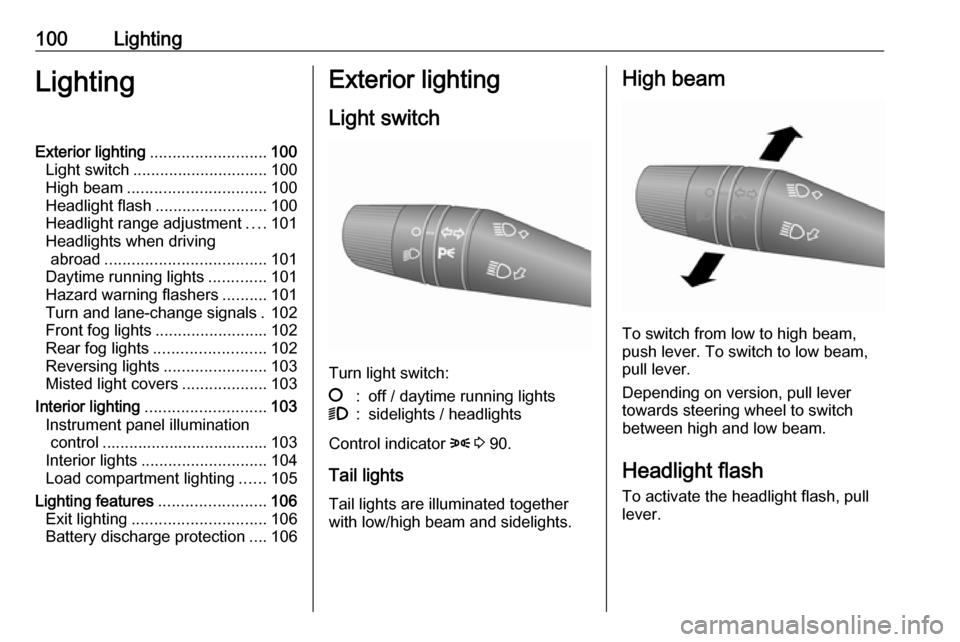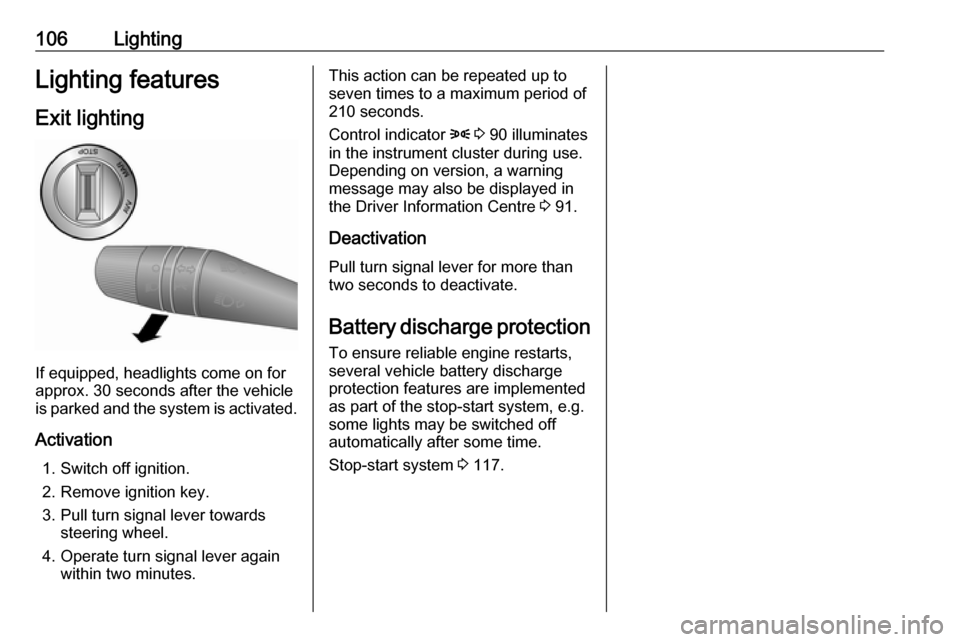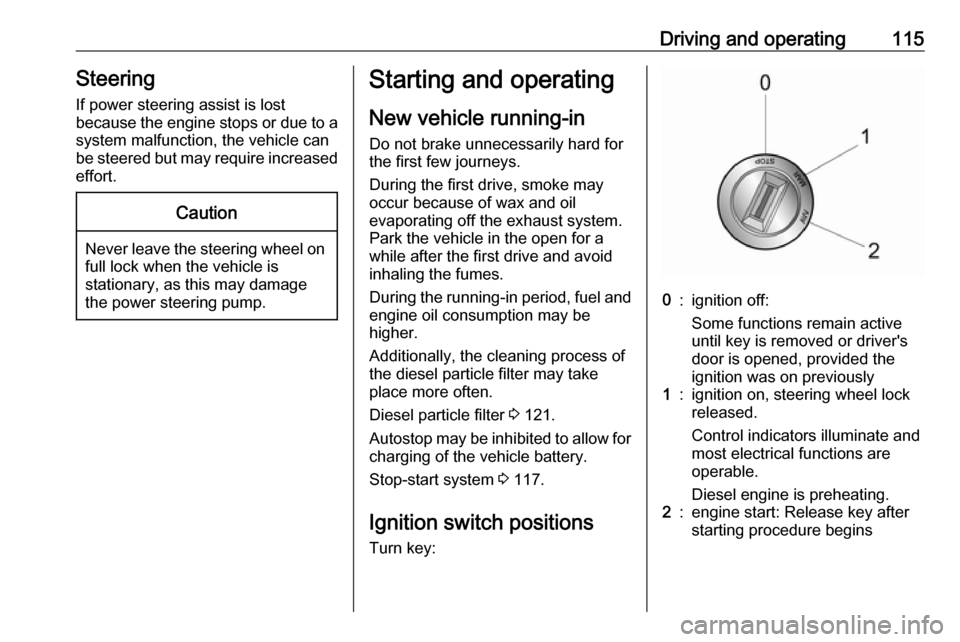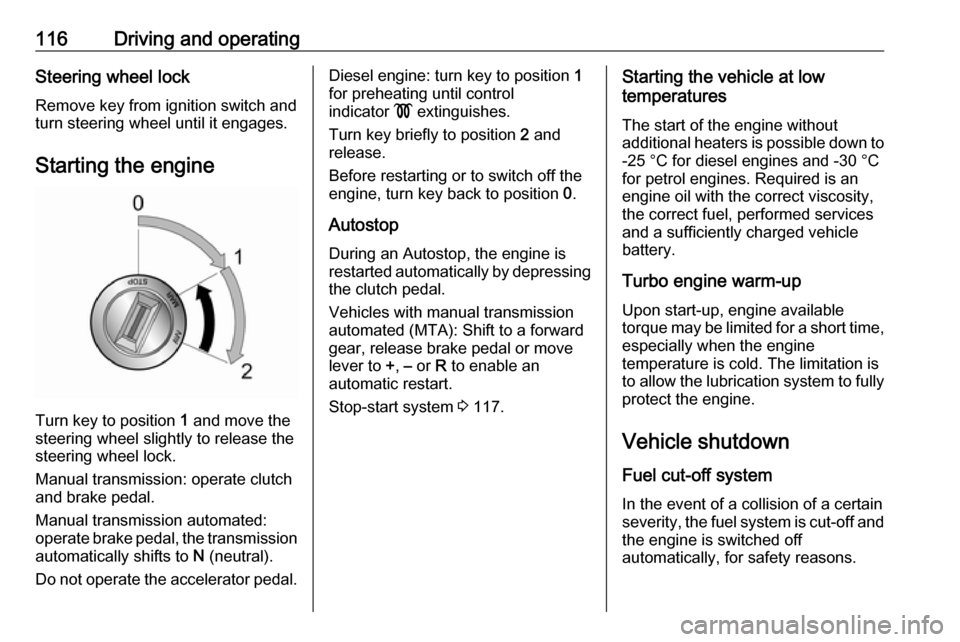steering OPEL COMBO D 2018 Manual user
[x] Cancel search | Manufacturer: OPEL, Model Year: 2018, Model line: COMBO D, Model: OPEL COMBO D 2018Pages: 203, PDF Size: 4.97 MB
Page 72 of 203

70Instruments and controlsInstruments and
controlsControls ....................................... 71
Steering wheel adjustment ........71
Steering wheel controls .............71
Horn ........................................... 71
Windscreen wiper/washer .........72
Rear window wiper/washer .......72
Headlamp washer .....................73
Outside temperature ..................73
Clock ......................................... 73
Power outlets ............................. 75
Cigarette lighter ......................... 76
Ashtrays .................................... 76
Warning lights, gauges and indi‐ cators ........................................... 77
Instrument cluster ......................77
Speedometer ............................. 77
Odometer .................................. 77
Trip odometer ............................ 77
Tachometer ............................... 77
Fuel gauge ................................ 78
Fuel selector .............................. 78
Engine coolant temperature gauge ....................................... 79
Service display .......................... 79Transmission display .................80
Control indicators ......................80
Generic warning ........................82
Turn signal ................................. 83
Seat belt reminder .....................83
Airbag and belt tensioners .........83
Airbag deactivation ....................84
Charging system .......................84
Malfunction indicator light ..........84
Brake system ............................. 85
Brake pad wear ......................... 85
Antilock brake system (ABS) .....85
Transmission ............................. 85
Gear shifting .............................. 86
Hill start assist ........................... 86
Ultrasonic parking assist ...........86
Electronic Stability Control ........86
Engine coolant temperature ......87
Preheating ................................. 87
Diesel particle filter ....................87
Tyre pressure monitoring system ...................................... 88
Engine oil pressure ....................88
Change engine oil .....................89
Low engine oil level ...................89
Low fuel ..................................... 89
Drain fuel filter ........................... 90
Immobiliser ................................ 90
Stop-start system ......................90
Exterior light .............................. 90High beam................................. 90
Fog light ..................................... 91
Rear fog light ............................. 91
Cruise control ............................ 91
Door open .................................. 91
Information displays .....................91
Driver Information Centre ..........91
Vehicle messages ........................96
Warning chimes .........................96
Fuel system messages ..............97
Trip computer ............................... 97
Page 73 of 203

Instruments and controls71Controls
Steering wheel adjustment
Unlock lever, adjust steering wheel,
then engage lever and ensure it is
fully locked.
Do not adjust steering wheel unless
vehicle is stationary and steering
wheel lock has been released.
Steering wheel controls
The Infotainment system and a
connected mobile phone can be
operated via the controls on the
steering wheel.
Further information is available in the
Infotainment manual.
Horn
Press j.
The horn will sound regardless of
ignition switch position.
Page 87 of 203

Instruments and controls85Flashes when the engine is
running
Fault that could lead to catalytic
converter damage. Ease up on the accelerator until the flashing stops.
Seek the assistance of a workshop
immediately.
Depending on version, a warning
message may also be displayed in
the Driver Information Centre 3 91.
Brake system
R illuminates red.
Illuminates after the ignition is
switched on if the parking brake is
applied 3 128. A warning chime will
sound if a certain speed is exceeded
with the parking brake applied.
Illuminates when the parking brake is
released if the brake fluid level is too
low 3 146.9 Warning
Stop. Do not continue your
journey. Consult a workshop.
Illuminates if the brake vacuum servo
fails; the brake pedal becomes stiff
when pressed. The brake system
remains operational however,
assistance will be reduced. The
steering may also require
considerably more effort when
turning.
Depending on version, a
corresponding warning message,
e.g. Brake fluid level insuff. , may also
be displayed in the Driver Information Centre 3 91.
Brake pad wear
F illuminates yellow.
The front brake pads are worn, seek
the assistance of a workshop
immediately.
Depending on version, a
corresponding warning message, e.g. Check brake pads , may also be
displayed in the Driver Information
Centre 3 91.Antilock brake system
(ABS)
u illuminates yellow.
Illuminates for a few seconds after the
ignition is switched on. The system is ready for operation when the controlindicator extinguishes.
If the control indicator does not
extinguish after a few seconds, or if it
illuminates while driving, there is a
fault in the ABS. The brake system
remains operational but without ABS
regulation.
If u illuminates together with R,
there is a fault in the braking system. Depending on version, a
corresponding warning message,
e.g. ABS unavailable , may also be
displayed in the Driver Information
Centre 3 91. Seek the assistance of
a workshop immediately.
Antilock brake system 3 127.
Transmission
s illuminates red.
Illuminates for a few seconds after the ignition is switched on.
Page 91 of 203

Instruments and controls899Warning
When the engine is off,
considerably more force is needed
to brake and steer. During an
Autostop the brake servo unit will still be operational.
Do not remove ignition key until
vehicle is stationary, otherwise the steering wheel lock could engage
unexpectedly.
Check oil level before seeking the
assistance of a workshop 3 144.
Change engine oil Diesel engines with diesel particle
filter
I flashes red.
Illuminates when the ignition is
switched on and extinguishes shortly
after the engine starts.
The engine oil life monitor lets you know when to change the oil. Control
indicator I will flash to indicate that
engine oil life has been diminished
and the oil needs changing.
Depending on version, a
corresponding warning message,
e.g. Change engine oil , may also be
displayed in the Driver Information
Centre 3 91.
Based on driving conditions, the
interval at which an oil change will be
indicated can vary considerably.
Depending on model variant, I may
flash in the following ways:
● for one minute every two hours, or
● for three minute cycles with I off
for intervals of five seconds
The warning will be repeated every
time the engine is started, until the
engine oil is changed and the service display is reset. Seek the assistance
of a workshop.
Service display 3 79.
Low engine oil level
S illuminates red.
Illuminates for a few seconds after the ignition is switched on.If the control indicator does not
extinguish after a few seconds, or if it illuminates while driving, the engine
oil level is insufficient.
Depending on version, a
corresponding warning message,
e.g. Check engine oil level , may also
be displayed in the Driver Information
Centre 3 91.
Check oil level before seeking the assistance of a workshop 3 144.
Low fuel $ illuminates or flashes yellow.
Illuminates for a few seconds after the ignition is switched on.
Illuminates
Level in fuel tank is too low. Refuel
immediately 3 136.
Never run the tank dry.
Depending on version, a
corresponding warning message,
e.g. Warning low fuel , may also be
displayed in the Driver Information Centre 3 91.
Catalytic converter 3 121.
Page 102 of 203

100LightingLightingExterior lighting.......................... 100
Light switch .............................. 100
High beam ............................... 100
Headlight flash ......................... 100
Headlight range adjustment ....101
Headlights when driving abroad .................................... 101
Daytime running lights .............101
Hazard warning flashers ..........101
Turn and lane-change signals . 102
Front fog lights ......................... 102
Rear fog lights ......................... 102
Reversing lights .......................103
Misted light covers ...................103
Interior lighting ........................... 103
Instrument panel illumination control ..................................... 103
Interior lights ............................ 104
Load compartment lighting ......105
Lighting features ........................106
Exit lighting .............................. 106
Battery discharge protection ....106Exterior lighting
Light switch
Turn light switch:
§:off / daytime running lights9:sidelights / headlights
Control indicator 8 3 90.
Tail lights Tail lights are illuminated together
with low/high beam and sidelights.
High beam
To switch from low to high beam,
push lever. To switch to low beam,
pull lever.
Depending on version, pull lever
towards steering wheel to switch
between high and low beam.
Headlight flash To activate the headlight flash, pull
lever.
Page 104 of 203

102LightingDepending on version, hazard
warning flashers may come on
automatically during hard braking.
Turn and lane-change signalsLever up:right turn signalLever down:left turn signal
A resistance point can be felt when
moving the lever.
Constant flashing is activated when
the lever is being moved beyond the
resistance point. It is deactivated
when the steering wheel is moved in
the opposite direction or lever is
manually moved back to its neutral
position.
Activate temporary flashing by
holding the lever just before the
resistance point. Turning lights will
flash until lever is being released.
To activate five flashes, tap the lever
briefly without passing the resistance
point.
Front fog lights
Operated by pressing >.
Switching on front fog lights will
switch sidelights on automatically.
Press > again to turn the front fog
lights off.
Rear fog lights
Operated by pressing ø.
The rear fog light can only be
switched on when both the ignition
and headlights or sidelights (with front
fog lights) are on.
Press ø again to turn the rear fog
light off, or turn off the headlights
and/or the front fog lights.
Page 108 of 203

106LightingLighting featuresExit lighting
If equipped, headlights come on for
approx. 30 seconds after the vehicle
is parked and the system is activated.
Activation 1. Switch off ignition.
2. Remove ignition key.
3. Pull turn signal lever towards steering wheel.
4. Operate turn signal lever again within two minutes.
This action can be repeated up to
seven times to a maximum period of
210 seconds.
Control indicator 8 3 90 illuminates
in the instrument cluster during use.
Depending on version, a warning
message may also be displayed in
the Driver Information Centre 3 91.
Deactivation Pull turn signal lever for more thantwo seconds to deactivate.
Battery discharge protection
To ensure reliable engine restarts,
several vehicle battery discharge
protection features are implemented
as part of the stop-start system, e.g.
some lights may be switched off
automatically after some time.
Stop-start system 3 117.
Page 116 of 203

114Driving and operatingDriving and
operatingDriving hints ............................... 114
Control of the vehicle ...............114
Steering ................................... 115
Starting and operating ...............115
New vehicle running-in ............115
Ignition switch positions ...........115
Starting the engine ..................116
Vehicle shutdown ....................116
Overrun cut-off ........................ 117
Stop-start system ....................117
Parking .................................... 120
Engine exhaust .......................... 121
Diesel particle filter ..................121
Catalytic converter ...................121
Manual transmission ..................122
Manual transmission automa‐ ted .............................................. 123
Transmission display ...............123
Starting the engine ..................123
Selector lever .......................... 123
Manual mode ........................... 125
Electronic driving programmes 125
Fault ........................................ 126Brakes........................................ 127
Antilock brake system .............127
Parking brake .......................... 128
Brake assist ............................. 128
Hill start assist ......................... 128
Ride control systems .................129
Traction Control system ..........129
Electronic Stability Control ......130
Driver assistance systems .........131
Cruise control .......................... 131
Parking assist .......................... 132
Fuel ............................................ 135
Fuel for petrol engines .............135
Fuel for diesel engines ............135
Fuel for natural gas operation . 136
Refuelling ................................ 136
Fuel consumption - CO 2-
Emissions ............................... 138
Trailer hitch ................................ 139
General information .................139
Driving characteristics and towing tips .............................. 139
Trailer towing ........................... 139Driving hints
Control of the vehicle
Never coast with engine not
running (except during Autostop)
Many systems will not function in this
situation (e.g. brake servo unit, power
steering). Driving in this manner is a
danger to yourself and others. All
systems function during an Autostop,
but there may be a controlled
reduction in power steering assist and
vehicle speed is reduced.
Stop-start system 3 117.
Pedals
To ensure the pedal travel is
uninhibited, there must be no mats in the area of the pedals.
Use only floor mats which fit properly
and are fixed by the retainers on the
driver's side.
Driving downhill
Engage a gear when driving downhill to ensure that sufficient brake
pressure is available.
Page 117 of 203

Driving and operating115SteeringIf power steering assist is lost
because the engine stops or due to a
system malfunction, the vehicle can
be steered but may require increased
effort.Caution
Never leave the steering wheel on
full lock when the vehicle is
stationary, as this may damage
the power steering pump.
Starting and operating
New vehicle running-in Do not brake unnecessarily hard for
the first few journeys.
During the first drive, smoke may
occur because of wax and oil
evaporating off the exhaust system.
Park the vehicle in the open for a
while after the first drive and avoid
inhaling the fumes.
During the running-in period, fuel and engine oil consumption may be
higher.
Additionally, the cleaning process of
the diesel particle filter may take
place more often.
Diesel particle filter 3 121.
Autostop may be inhibited to allow for
charging of the vehicle battery.
Stop-start system 3 117.
Ignition switch positions Turn key:0:ignition off:
Some functions remain active
until key is removed or driver's
door is opened, provided the
ignition was on previously1:ignition on, steering wheel lock
released.
Control indicators illuminate and
most electrical functions are
operable.
Diesel engine is preheating.2:engine start: Release key after
starting procedure begins
Page 118 of 203

116Driving and operatingSteering wheel lock
Remove key from ignition switch and
turn steering wheel until it engages.
Starting the engine
Turn key to position 1 and move the
steering wheel slightly to release the
steering wheel lock.
Manual transmission: operate clutch
and brake pedal.
Manual transmission automated:
operate brake pedal, the transmission
automatically shifts to N (neutral).
Do not operate the accelerator pedal.
Diesel engine: turn key to position 1
for preheating until control
indicator ! extinguishes.
Turn key briefly to position 2 and
release.
Before restarting or to switch off the
engine, turn key back to position 0.
Autostop During an Autostop, the engine is
restarted automatically by depressing
the clutch pedal.
Vehicles with manual transmission
automated (MTA): Shift to a forward
gear, release brake pedal or move
lever to +, – or R to enable an
automatic restart.
Stop-start system 3 117.Starting the vehicle at low
temperatures
The start of the engine without
additional heaters is possible down to -25 °С for diesel engines and -30 °C
for petrol engines. Required is an engine oil with the correct viscosity,
the correct fuel, performed services
and a sufficiently charged vehicle
battery.
Turbo engine warm-up Upon start-up, engine available
torque may be limited for a short time, especially when the engine
temperature is cold. The limitation is
to allow the lubrication system to fully
protect the engine.
Vehicle shutdown
Fuel cut-off system In the event of a collision of a certain
severity, the fuel system is cut-off and
the engine is switched off
automatically, for safety reasons.